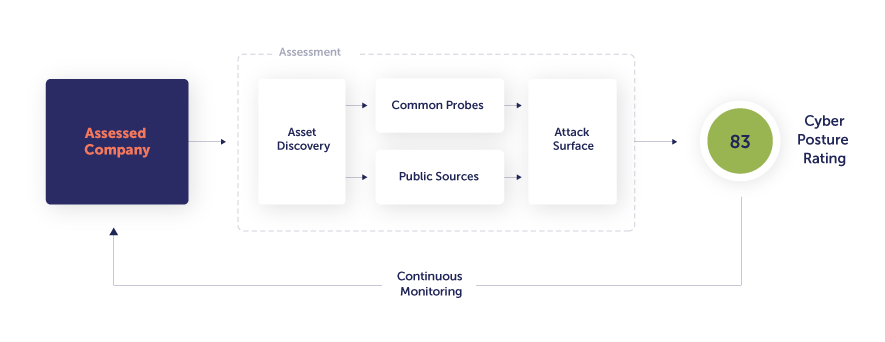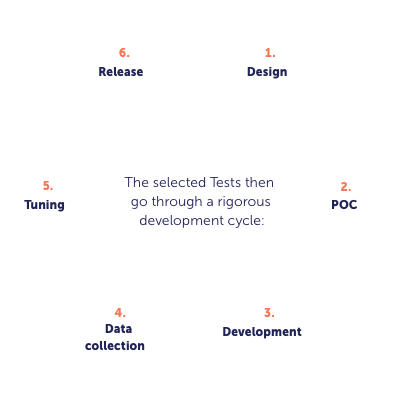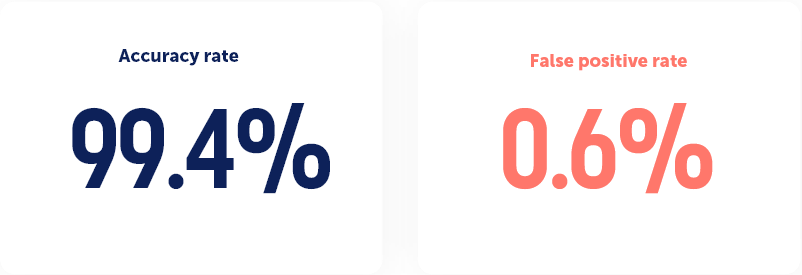Cyber Posture Rating Explained

Introduction
Given the precipitous rise in ransomware and data breaches, it’s important for organizations to mitigate their own cyber risk and also bring the security of their third parties into alignment with their security controls, regulations and risk appetite. To help do that, Panorays non-intrusively evaluates your own company’s and your third parties’ attack surface by performing hundreds of tests, such as collecting information on exposed assets or checking a lack of security best practices. Once the analysis is completed, typically within hours, each company assessed receives a Cyber Posture Rating from 0–100, representing the risk level attributed to its external digital perimeter. To help you manage the security risk related to your third parties, Panorays combines this rating with the results of the third party’s Smart Questionnaire™ and the business context of your relationship, providing you with a rapid, accurate view of supplier cyber risk.
01 External Attack Surface Assessment
Overview
Panorays evaluates each company’s attack surface in a non-intrusive manner, through the analysis of externally available data. To ensure a comprehensive view of an organization’s digital perimeter, Panorays performs hundreds of tests to assess three different layers:
Network & IT
Application
Human
Example findings within the Network, IT and Application layers could include untrusted TLS certificates, a missing WAF on a significant asset, exposure of WordPress user data, an unpatched application version, etc. In addition, Panorays considers the effect of human behavior in a company’s external attack surface assessment—and is the only platform that does so. Example findings here could include high employee attack likelihood based on social media presence, lack of employee security awareness or the absence of a dedicated security team.
Asset Discovery Mechanism
Taking one step back, before we can start performing the external assessment tests, we need to identify every publicly accessible asset linked to the evaluated company. Asset discovery is done automatically by the Panorays platform, requiring only a single asset to get started. Usually, the primary domain of a company is used as a starting point for discovering all of the company’s attack surface, including domains, subdomains and IP addresses.
Continuous Monitoring
While the initial assessment is typically completed within hours, Panorays continuously updates the Cyber Posture Rating based on changes to the company’s external footprint. That’s because a point-in-time view doesn’t keep up with the evolving risk landscape, as risk can change by the second. Security teams receive live alerts about any security changes or breaches to their company or third parties.
Non-Intrusive Assessment
As the assessment is external and not intrusive, it is performed by Panorays without engaging with the assessed company itself. That being said, you and your third parties can easily dispute irrelevant assets or findings through the platform. This external mechanism enables quick results, typically within hours, while maintaining an extremely high accuracy rate. Assessment data is collected from both public sources, such as asset reputation feeds, and common probes, such as sending an empty email to see whether a destination actually exists. As for the amount and level of information obtained using an external assessment, the results are staggering:
- Some of the public sources include feeds, such as botnet activity, which allow for a deeper internal look of the company without the need to be intrusive.
- Probing company services, including but not limited to web servers, mail servers, DNS, SNMP, SSH and NTP, can reveal security configurations and practices performed by the company.
- Panorays provides specific vulnerability information; for example, by technology version, CVE correlation or from bug bounty programs.

02 Cyber Posture Rating Methodology
Overview
The basis of the Panorays Cyber Posture Rating methodology is the Test entity. Each assessment consists of hundreds of Tests that run on the evaluated company assets (servers, DNS, IP ranges, employees, etc.).
The results of each Test generate findings (e.g. cyber gaps) and a Test rating. The aggregation of all Test ratings generates the final Cyber Posture rating of the company.
Some Test examples:
- Do the company mail servers have an SPF record?
- Do the company web servers support deprecated SSL protocols?
- Are company assets flagged as hosting malicious activities?
Test Rating Calculations
Each Test has its own internal 0–100 rating, which is rated as follows:
100:
The Test was performed but no findings were detected (all assets passed the Test).
0:
The Test was performed and all assets failed the Tests (findings count = assets count).
N/A:
The Test could not be performed (e.g. no SNMP server was detected so the SNMP Test could not be run).
1–99:
Some assets passed the Test while others failed.
Each Test has different rating calculation functions, to ensure the most accurate results. The different calibration parameters are as follows:
Simple relativity. For example, if two out of 10 assets have a finding, the Test rating will be 80.
Statistics. For example, if one out of 100 assets has an open database, Panorays won’t rate the Test as 99.
Company and industry standards. For example, a company with 20 employees should not have the same security team size as a company with 20,000 employees.
The Development of Tests
Panorays develops Tests based on both industry best practices, such as OWASP and NIST, and the cybersecurity knowhow of our team of research experts. The team continually adds new Tests based on changes to the threat landscape and Panorays’ extensive experience in this domain.
The team answers the following questions for each Test under review, in order to decide whether to add it to the assessment engine:
- What can the Test tell us about the cyber posture of the company?
- What is the Test severity?
- Can the Test be performed in a non-intrusive manner?

In particular, the Data Collection and Tuning phases are crucial. Every Test is initially deployed in hidden mode to collect data from the tens of thousands of companies in the Panorays database. The data is then used to corroborate the researcher’s knowhow and tune the severity and weight of the Test.
For example, Panorays researchers initially set a baseline of medium severity and weight for the existence of DNSSEC. After running the Test on all companies in the Panorays database, the researchers obtained the following information:
- 97% of companies don’t have DNSSEC at all
- The average test rating is 1.7 points out of 100
- A trusted companies dataset (Google, Amazon, Microsoft, etc.) has an average rating of 1.6 points
The results indicated that DNSSEC is not widely adopted, therefore, the Test weight should be tuned appropriately. The results are verified and approved by the researcher before finally being added to the assessment.
Test Categories
The Tests are divided into three top-level sections: Network and IT, Application and Human.
The rating for each category is an aggregation of ratings for all the Tests that run under this category. The category ratings help the user focus on problematic areas in the assessment and compare evaluated companies based on specific categories.
Note: The final rating is not derived from the category ratings, but directly from the Test ratings. This is done in order to increase the accuracy of the Test’s impact, such as N/A Test results, critical findings, etc.
Assessment Release Management
The list of Tests, severities and weights is called an Assessment Template. There is a single enabled Assessment Template at any given time. Because changing the template may affect the Cyber Posture Rating, each change in the template (adding tests, changing weights, etc.) is documented and monitored.
Challenging False Positives
Panorays allows third parties to easily dispute findings and assets as follows:
- The supplier is invited to the Panorays platform to review findings and assets.
- If the supplier feels that any of the data is inaccurate, he or she simply clicks “claim dispute,” adds any comments about the finding or asset, and submits.
- Panorays validates the data internally within 24 hours, accepts or rejects the claim and updates the findings accordingly.
- The supplier’s Cyber Posture Rating is automatically updated according to the new external footprint assessment.

Summary
The Panorays Cyber Posture Rating delivers:
- Accuracy. The ratings consist of numerous Tests that are checked against a large dataset for distribution and a trusted dataset for validation. Ratings consider different aspects of companies like size and industry. Breached companies are systematically investigated to check that the ratings could give the appropriate indication for the breach.
- Transparency. All of the Tests performed by the assessment engine are displayed with their results. All parties can view the entire findings list and discovered assets that build the rating—and dispute any of
the findings, if necessary. - Consistency. The same Tests are performed for all companies. The rating is absolute.
- Stability. A company’s Cyber Posture rating is typically built from hundreds of Tests on thousands of assets. The rating provides an indication of the general cyber posture of the company and not of a specific finding.
FAQs
-
As the assessment is external and not intrusive, it is performed by Panorays without engaging with the assessed company itself. This means we do not have access to internal company resources. The amount and level of information obtained using an external assessment is remarkable, allowing Panorays to perform comprehensive, accurate assessments at scale, without the hassle of intrusive assessments requiring agents’ installation.
-
As the Panorays assessment is completely external, it does not perform active penetration tests such as running exploits or brute forcing. This does not prevent Panorays from identifying vulnerabilities related to the company assets. Many findings from Panorays’ non-intrusive tests provide specific vulnerability information (e.g. by technology version, CVE correlation or from bug bounty programs).
-
Speed and Scalability
Penetration tests are active and intrusive. They require consent and coordination with the assessed party, as they can cause disruption of services. Automated pentesting tools require an agent, and hence the installation and maintenance from the side of the third party.
Panorays is a SaaS-based platform, requiring no installation on the customer or third-party side. Panorays’ external assessment requires minimal effort from the assessing company — simply adding the assessed company name and domain. The assessment is typically completed within a few hours, enabling organizations to perform assessments at scale.Breadth
Panorays’ assessments are generally more comprehensive than penetration tests, as they include all of the company’s publicly-facing assets, also known as the external attack surface. The Panorays assessment engine can identify changes in the attack surface, such as added assets, and update the ratings and findings accordingly.
Continuous View
A pentest will be invalid a day after it is performed; for example, if a new vulnerability comes out. Panorays’ assessment is continuous, alerting security teams about any security changes or breaches to their third parties.
-
Vulnerability scanners are web-based tests on pre-defined assets. They run intrusive scans that require consent from the third party. Panorays’ assessments are much more comprehensive, and do not require consent.